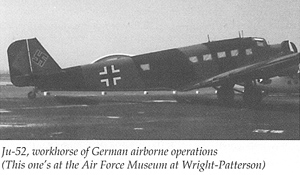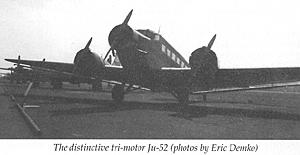 Ju-52, workhorse of German airborne operations (This one's at the Air Force Museum at Wright-Patterson)
Ju-52, workhorse of German airborne operations (This one's at the Air Force Museum at Wright-Patterson)
If you are like me, your first reaction to hearing about a game on the invasion of Holland in 1940 will be "Oh, so you play three days or so and the Dutch get creamed--oh, boy!" Aside from my natural inclination toward the strange and back-water areas of WW2 (places where even a little more information would add greatly to what I know), this was exactly my reaction as well.
There are two problems with this assumption of guilt. First, the game only covers the first four days of the campaign. Second, it does this by covering (in great detail) the area of the German airdrops. "So?" you ask. The German airdrops were a near run thing (parts of it actually turned into disasters). The issue isn't as clear-cut as you would think.
Basic Stuff
Fallschirmjaeger, an SCS game due out in April, covers the area around The Hague and Rotterdam in north-central Holland. The map is at a scale of I Kin per hex and each turn (except for the first two "special" turns) is 8 hours. Units range from platoon to company. The game comprises one map, three scenarios (and room for more in the magazine), and 560 counters (mostly units). The game has a fast, semi-tactical, feel.
History
Originally, Holland wasn't really part of the Fall Gelb plan presented by that young Turk, von Manstein. Given the criticism of the Younger Moltke's handling of the great German offensive in 1914, the decision was made early on to violate Dutch neutrality and cross the small finger of land in the far south (the point of which causes headaches to Drive on Paris players). The plan, as it was, continued to grow.
Adding the capture of the whole of Holland to the plate was something the Germans chose to do so as to cover the flank of the advancing panzers. Also, if done correctly, an invasion of Holland would play into Allied thinking that the German plan really would be a replay of 1914 (causing them to rush northward to meet the supposed German spearhead only to be cut off by the German main effort further south).
Furthermore, the effort in Holland would require a minimal commitment of forces (so as not to dilute the main effort). The terrain of Holland is such that some major rivers will need to be crossed in any advance from south to north. While the German effort did include advances directly from the east, the area of concern in the game is the drive from south to north off the advance to the west from further south (running around the main Dutch defenses). Grabbing these river crossings right away would be the key to taking the area around Rotterdam and The Hague using as few troops as possible. Should the Dutch control these crossings, a major effort would be required to force each of these rivers.
To grab the crossings right as the offensive began was a job that fell to Kurt Student and his paratroopers (Fallschirnijaeger or Fallschirmjdger in German). The smaller drops in earlier campaigns were nothing compared to this landing-the first major airborne offensive in history. Student's 7 Flieger Division would drop on the positions and hold them (with the support of air landed 22 Luftlande Division troops) until the "cavalry" in the form of the 9th Panzer Division and a smattering of SS troops arrived to relieve them. If that sounds like Market-Garden, you are right. It is the same layout-with almost the same results.
Having learned the lessons of the German invasions of Norway and Denmark, the Dutch army prepared itself (as best it could) for a potential airborne invasion. It did this while, at the same time, continuing the facade of neutrality (which lead to the emplacement of troops and forts guarding the south (against the French) and the sea (against the British).
In the area of the game, you see Dutch troops scattered all over the map. This is the classic defense against a parachute assault (or guerrilla fighting for that matter) as it allows local forces to take on the parachutists before they have a chance to consolidate and get organized. The Dutch were ready and started counterattacks right away.
The German landings were in three main sectors on 10 May and after: Dordrecht/ Moerdijk (to gain the crossing over the Hollandsch Diep and at Dordrecht), Rotterdam (crossings over the Maas), and Den Haag (the capitol city). Key to each of these operations was the quick seizure of local airfields so as to allow the air landing troops to enter and to provide a means of supplying the pocketed German paratroops.
Speed and violent execution are the keys to any successful airborne operation. Troops will be scattered and commands intermingled as a matter of course, but this can be used to advantage if the troops and lower level leaders have aggressive initiative and the flexibility to deal with the situation as it is, not how it was supposed to be. The German paratroopers had all these things. Taking the bridges over the Maas in central Rotterdam was deemed the most difficult of the objectives, so special efforts were made to grab those bridges rapidly and to hold them against the expected Dutch attacks (Rotterdam was well garrisoned). To do this, one platoon of paratroops was to jump into the stadium at the edge of the city and to make their way to the bridges to link up with the other special landingthe seaplanes. One company from the 22 LL Division was to land right on the river in downtown Rotterdam in He-59 seaplanes. The seaplanes allowed a stealthy insertion of heavily armed men with none of the scatter involved in parachute landings. Both of these efforts are captured in the game for players to use.
 The distinctive tri-motor Ju-52 (photos by Eric Demko)
The distinctive tri-motor Ju-52 (photos by Eric Demko)
Those two operations went as planned. The stadium platoon made their drop and rode the city trams to the bridge. Puzzled Dutch citizens (still disbelieving that an invasion was underway) watched the seaplanes land and taxi right up to the bridges. A Dutch policeman actually went up to the seaplane assault troops and attempted to arrest them (illegal landing of a seaplane in city waters?). They killed him. The Maas River bridges were captured (intact) in the first hours of the offensive. For the next days, the Germans clung to the bridge under violent Dutch attack. They kept a small bridgehead on the northern bank, a larger one on the southern, and maintained control of the bridges until the end of the battle. Near Rotterdam, the Waalhaven airfield was captured and allowed intermittent reinforcement (the Dutch did their best to deny the facility to the Germans with air and artillery barrages and counterattacks).
Likewise, the Dordrecht landings went well and the bridges there fell under German control. Dutch counterattacks continued for the rest of the battle, but the Germans were able to hold this area until the 9th Panzer Division arrived on the 13th of May. The few French units sent to this area became embroiled in this fight.
Den Haag was a different story. Landings in that zone scattered badly. The airfields changed hands several times. Finally, the crippled remains of the 22 LL Division had to cut their way back to link up with the Germans at Rotterdam. This part of the operation failed. This assault's value was that it caused the Dutch to pull in troops to resist it, rather than defend other, potentially more critical locations. Expensive bait.
In the end, the 9th Panzer Division and the SS-Liebstandarte Regiment arrived to relieve the remaining paratroopers and forced the garrison of Rotterdam to surrender on 14 May after a confused air strike on the city that lent itself to Allied propaganda purposes as an example of German brutality and excess. The final assault on Rotterdam is beyond the scope of the game.
The Game
So, what is a player to do? In rough terms, the German player needs to direct his air drops and air landings to seize control of the key bridges as fast as possible and then to hold them against all comers until the German ground forces arrive toward the end of the game. He can do this using the historical drop sites or any of his own desire. Even his defense actions cannot afford to become static. The defense must be active and include as many German attacks as possible (to use his forces in their best light).
The Dutch player, meanwhile, must use everything under his power (AA fires, ships, standing barrages, General Winkelmann, and piles of troops) to crush the various German landings, retake the airfields and bridges, and evacuate the Queen, the Government, and the Dutch Gold Reserve.
The Dutch gain VPs by killing off German parachute platoons (some of which can be reorganized by Student as ad hoc companies), grabbing some real estate, taking Student or Sponeck POW, and taking credit for Ju-52 transports destroyed. The Germans get VPs for terrain, taking POWs (Queen, Government, Winkelmann, the Gold), and for extending a cleared line of communications from the south map edge.
Special rules cover the airdrop and air landings, artillery, AA, and support fires of weapons units, the seaplanes and stadium jumpers, leaders, ships, Dutch artillery ammo problems, air supply heads, British and French intervention, engineer-emplaced bridges, assault troops, and even an armored train.
The first two game turns (pre-dawn, as it were, 10 May) allow the Germans to do their airdrops and some minor attacks (along with some minor Dutch counterattacks), but the real game turns do not begin until turn 3. The campaign game lasts until turn 15 and will take experienced players about 4 hours to complete. The game works well with more than 2 players (because it divides into sectors nicely), but certainly can be played solitaire. In complexity it is about on par with Drive on Paris.
Conclusion
I was personally surprised at how far off my "This is a German cakewalk" impression was from the actual situation. If anything, the game is hard on the Germans (as it should be given the historical results). The game's semi-tactical feel gave me all kinds of ideas for other situations that could be crafted using similar rules. In short, I had a lot of fun working on this game's development (original design by Al Wambold) and am greatly impressed with the sheer amount of historical detail crammed into this fun and playable game.
And, yes, the map was checked by Dutch experts to ensure accuracy and 1940 detail.
Back to Table of Contents -- Operations #40
Back to Operations List of Issues
Back to MagWeb Master List of Magazines
© Copyright 2001 by The Gamers.
This article appears in MagWeb (Magazine Web) on the Internet World Wide Web.
Other military history articles and gaming articles are available at http://www.magweb.com